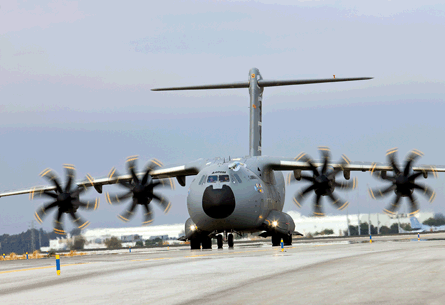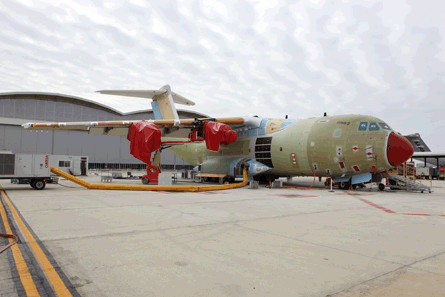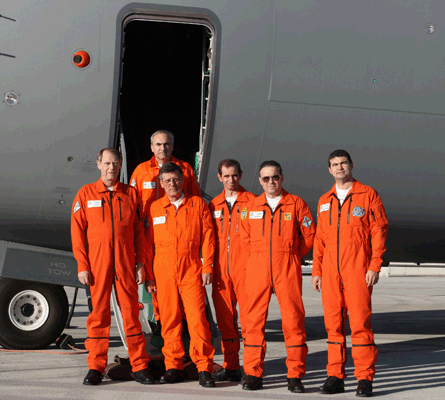The scheduled first flight of the A400M transport on 11 December is the starting point for three years of intense flight-test activity. To be conducted throughout Europe, and later at many other locations across the globe, the work will prepare the type for its revised entry into service target of December 2012.
Just over a week before the planned flight debut of aircraft MSN001, EADS-led Airbus Military outlined its plans to log some 4,370 flight hours with an eventual fleet of five A400M test aircraft within the next 36 months.
Being developed for seven European launch customers and export buyer Malaysia, the new type should also succeed in securing both EASA type certification and completing military qualification and certification activities within this time, after work totalling 1,850h and 2,520h, respectively.
 |
|---|
© Airbus MilitaryThe first of five test aircraft, MSN001 should amass 1,200 flight hours before the A400M enters service in December 2012 |
After making an unspecified number of flights from San Pablo airport near Seville, Spain, where Airbus's massive final assembly facility for the A400M dominates the landscape to the north side of the single runway, MSN001 will be transferred to Toulouse.
The aircraft will head up a three-strong test fleet at the site, with this also to include the programme's third and sixth production examples. MSN001 is expected to amass half of the total 2,400h scheduled to be flown by the French-based assets by late 2012. Remaining flight-test activities, to total a projected 1,970h, will be conducted using aircraft MSN002 and 004, which will remain home-based at Seville for the duration of the campaign.
In development since 2004, the flight-test programme will address both civil certification needs and clearing the A400M's specific military characteristics. The latter work will be conducted in collaboration with Europe's OCCAR procurement agency, which manages the production contract between Airbus and launch customers Belgium, France, Germany, Luxembourg, Spain, Turkey and the UK.
"We are used to working with EASA from all previous [Airbus] civil programmes," says Eric Isorce, head of the A400M integrated flight-test operations team responsible for completing the transport's path to service entry. "They know Airbus aircraft. It is easy to discuss with them and to have a first achievement in terms of type certification." The milestone is targeted for late November 2011, he adds.
The flight-test programme has been drawn up in accordance with Joint Aviation Authorities 32 rules, and the Airbus team will not repeat military certification activities for individual nations, removing duplication from the process, says Ed Strongman, the company's chief test pilot, military programmes.
A large number of aspects will be covered during the military certification process, spanning the so-called common standard aircraft configuration agreed by the partner nations. For example, "the roll rates required for the A400M are much more sporty and fast than one would normally expect, or accept, for a civil aircraft", says Strongman. "That's true throughout the whole military functions."
PRECISE TASKS
Each of the five test airframes has been allocated a precise set of tasks, says Isorce, who notes that the fleet will have some common basic capabilities, enabling work to be transferred to another asset if required.
Aircraft one and two, which will conduct a combined 2,300h of testing, will each carry a heavy instrumentation load of between 14t and 16t. Their activities will include aircraft handling, loads and flutter characteristics, plus performance, certification and defensive aids systems, says Isorce.
Medium instrumentation will be installed on aircraft three and four, which will conduct testing on systems such as autopilot, fuel, hydraulics and navigation, and cargo operations and air-to-air refuelling work, respectively.
 |
|---|
Click on the above graphic to see full size |
Aircraft six will be the first production-representative example of the A400M, and will perform duties such as route proving and engine endurance, as well as testing overall maturity. It will carry light instrumentation.
Original plans were to have employed MSN005 as part of the test fleet, but Strongman says this would only have been available "within the last six months of the programme", prompting the shift to using a full production example. "We will do tests on a real, final-assembled aeroplane," he adds.
Strongman is optimistic that the programme's first aircraft will soon be flying regularly after its historic debut. "Within a month or so, we'll be building up to high rates of maybe two flights a day," he says. This momentum will be achieved by aiming to fly the aircraft on each weekday, conducting regular maintenance at night and more major support tasks at weekends.
"By mid-year, we'll have the third aircraft, so it will be very busy," he says, referring to MSN003's planned first flight in May. All five test assets should be available by July 2011.
A multinational test team will operate the aircraft and their systems using a single set of flight rules created over the past two years, says Isorce. "We are one single team, whether we have military or civil experience."
Test activities will, in time, be conducted from locations across France, Germany, Spain, Turkey and the UK, and will cover the development of tactical flying, air- and para-drop tasks and operations from unpaved runways, including dry and wet grass and soil. Further studies will be carried out to complete assessment of crew workload levels.
Agreements were made with the partner countries more than 18 months ago about them providing national assets such as fighter and tanker aircraft and personnel, or the use of test facilities, to support the process.
TELEMETRY ROOMS
Although MSN001 will make its first flight with only six people aboard, a team of about 100 engineers will also take part in the event from the ground, within telemetry rooms in Seville and Toulouse. Seven large antennas have been installed in France and five in Spain to support their work.
Equipped with datalinks, the aircraft will be able to relay key information about its engines, systems and performance in real time. The status of its fuel system will also, in the future, be relayed to Rolls-Royce's Filton site near Bristol in the UK, and to Bremen, Germany for its cargo system.
The set-up will be able to handle data from two flights simultaneously, and a mobile centre will support activities from locations away from the two main centres, for example while work is performed at sites such as Cazaux and Istres in France.
"We can share wherever the specialists are," says Isorce, who adds that the infrastructure "will give us more efficiency in monitoring the tests". The telemetry system has already been de-risked during flight testing of the Airbus A330-based multi-role tanker transport for the Royal Australian Air Force.
Further afield, cold-weather work will be conducted at two locations in Canada, and in Greenland and Sweden. "Hot and high" testing will be performed in Bolivia and Colombia, and "hot and humid" flights made in Guyana. Al Ain in the United Arab Emirates will host hot-weather testing, Tunisia will be the location for hot and sandy operations, and Mexico for high-altitude staging near the equator.
 |
|---|
© Airbus MilitaryThe programme's second aircraft is scheduled to fly for the first time in March 2010 |
High-latitude testing will be done from the Norwegian archipelago of Svalbard in the Arctic Ocean, and Keflavik in Iceland will host high-cross-wind operations trials.
Work will also, in time, move beyond the common standard aircraft configuration to begin addressing the range of options taken by some of the partner nations.
About half of the buyers have opted for a military radar supplied by Rockwell Collins, and at least three have previously ordered in-flight refuelling equipment. Every A400M will be piped to carry underwing Cobham 908E-series hose-and-drogue pods, and MSN001 already has markings beneath its wing to help pilots line up on the equipment, which will be positioned between the outer engine and wing tip.
Germany, which has picked the highest equipment specification for its 60 aircraft, is the only nation so far to select a CAT 3 autoland capability for its fleet. It will also use a terrain-following radar mode for some operations. Strongman expects the overall flight-test campaign for the A400M to last for at least four years after first flight.
Since aircraft MSN001 was transferred to the A400M flight-test department on 12 November, it has made swift progress toward its debut sortie, and several lessons have been learned along the way.
An early snag came when the aircraft's auxiliary power unit was "de-stored" but was unable to start its four Europrop International TP400-D6 engines. The fault was addressed, with a new software load being provided by EPI overnight.
The APU's exhaust "chimney", routed out of the upper starboard wing root, has shown good initial results, with recorded temperatures lower than expected. The exhaust's height is expected to be lowered subsequently.
Although it contributed to an overall programme delay by taking longer than expected to fly and complete its campaign, the TP400 flight testbed (FTB) provided a valuable service by identifying other potential issues. These included a rear wing heating problem on the host Lockheed Martin C-130K, addressed as a temporary fix on the A400M by adding more metal plate protection. A permanent solution will be installed from aircraft three, and retrofitted to the programme's first two test examples.
Nacelle cooling was also "a big problem for the FTB initially", says Strongman. This was addressed by adding an ejector to push out bleed air from the high-pressure compressor and reduce temperature. Airbus will define the parameters under which the modification is required to operate during further testing, but has, for now, adopted a fix so it works while the engines are at above 50% power setting while on the ground.
Overall, the A400M has shown "good engine response in normal operations and slams", says Strongman. Propeller pitch angle will be adjusted as the aircraft's crew gets a wider understanding of its neutral position, he says.
Restricted braking performance because of loose connectors caused tachometer readings to be lost and rear wheel braking to drop from over 138bar (2,000lb/in2) to about half that level during a rejected take-off at over 80kt. "We tested that further than we intended to," concedes Strongman.
Poor anti-skid braking was also encountered and was the subject of pre-flight modifications. Software fixes are also being sought to rectify an expected anomaly that results in erroneous data being provided by the aircraft's pitot tubes while it is taxied in reverse.
A few anomalies have also been found in the aircraft's electrics, but Strongman notes this was also encountered during testing of Airbus's last new commercial product. "All that work and learning with the A380 has come good," he says. "We're in a better position today."
 |
|---|
© Airbus Military |
Fixes are now being made rapidly, as engineering personnel at Airbus and its suppliers have worked round-the-clock to prepare for the first flight. "A year ago, life wasn't like this," says Strongman. "As people work together and know each other better, then the working relationship is much easier. There's a much better feeling of teamwork in people and wanting to build this aeroplane. It's really encouraging."
CUSTOMER DELIVERIES
Customer deliveries of the A400M will begin in December 2012 under current plans, with MSN007 scheduled to be handed over to launch operator the French air force. If the schedule holds firm, this will be more than three years behind the date of October 2009 originally agreed under the terms of Airbus Military's then-€20 billion ($29.5 billion) development and production contract.
First air show appearances are planned for Berlin and Farnborough in 2010, and at Paris in 2011. Future demonstration tours are scheduled to take in Australia, India, Malaysia, New Zealand, Peru and the UAE.
EADS is continuing discussions with its European customers over the terms of its 180-aircraft launch contract, which senior officials have previously described as unworkable. The company aims to complete this process with the nations through OCCAR before year-end, when it has also previously said it will halt work using its own funds.
Achieving the first flight of MSN001 before the talks conclude could be a pivotal factor in ensuring the A400M is safeguarded, and able to deliver on its design potential at last.
Source: Flight International
















